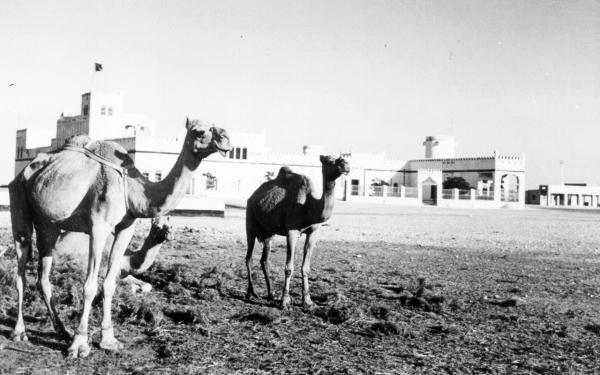



The Arabian camel is an animal that belongs to the camel family. It lives in the desert and is generally known as the dromedary. It is nicknamed the "Ship of the Desert" by Arabs, due to its ability to withstand long periods of heat and thirst, which can last up to a month in cold weather conditions. Female camels are locally known as "Naqa" in Arabic, while the plural form is "Nuq." The male camels, on the other hand, are known as "Ba'eer" in singular form, and "Ba'aran" or "Ba'arin" in plural form.
Home of the Arabian Camel
The camels are divided into two types: the Arabian camel, also known as the dromedary, and the Bactrian camel. These two types are distinct but share many similarities to the extent that what is said about one can broadly apply to the other. The Arabian camel inhabits the desert regions of North Africa and the Arabian Peninsula and has been introduced as a domesticated animal in India and Australia. The Arabian camel does not exist in the wild in a truly feral state, despite the presence of what is known as feral camels that have escaped domestication to roam freely.
On the other hand, the Bactrian camel lives in Asia, north of the Himalayan mountains, and is an important transport animal in the southern parts of Siberia and Mongolia. Free-roaming Bactrian camels also live in the Gobi desert and are believed to belong to wild herds; their thick coat of hair sheds at the end of winter.
According to the Ministry of Environment, Water, and Agriculture, the total number of camels in the Kingdom of Saudi Arabia is around 1.8 million, with 56 percent of them found in the regions of Riyadh, Makkah, and the Eastern Province, with more than 80,000 camel owners in Saudi Arabia. The total number of registered camels has exceeded 1.5 million since the launch of the registered camel project.
The distinctive features of the Arabian camel
Camels are among the animals mentioned in the Holy Quran, emphasizing their magnificent creation and remarkable adaptability. Allah says, "Do they not look at the camels, how they are created?" One of the distinctive features of camels is their ability to store food in their humps, where it is converted into trans fats through their digestive system. They can also store excess water they drink in the tissues of their three-chambered stomach, allowing them to retrieve and utilize it as a source of energy later when food is not available. They are also characterized by their split lips, which enable them to consume thorny plants easily. Camels can close their nostrils with their lips during sandstorms. Their long necks contain salivary glands that help them moisten dry plants.
Their thick skin enables them to withstand heat and insect bites, and their minimal sweat glands reduce water loss. Camels can adjust their body temperature to adapt to the surrounding environment. Their natural body temperature ranges between 34°C and 42°C, making them warm-blooded animals. Their eyes can endure dust storms as they have transparent eyelids that allow clear vision when closed and long eyelashes that protect their eyes.
The symbolism of the Arabian camel
The Arabian camel is the iconic symbol representing the culture of the Kingdom of Saudi Arabia. It has been intertwined with the lives of the inhabitants of the Arabian Peninsula since ancient times, serving as the primary mode of transportation for carrying goods and traveling long distances. This is reflected in the language of its people, where camels are mentioned in Arab proverbs, such as the saying, "I have neither a she-camel nor a male camel" used to politely decline involvement in an unrelated matter. The camel is also considered one of the famous symbols that Arab poets have extensively mentioned. For example, the poet Tarafa Ibn al-Abd describes the 'Awjah, the limping she-camel in his verses:
Yet, I have means to fly from grief, when such pursues me,
On a lean high beast which paces swiftly by day and by night,
A camel sure of foot, firm and thin as the planks of a bier,
Whom I guide surely over the trodden ways, ways etched in earth as texture is in cloth
Arabs also use endearing terms when riding camels, whether she-camel or a male camel. They call the males "ghazalan," "sharhan," "hamran," "abdan," and "buwaydhan," while the females are referred to as "qamarah," "hulwah," "sharhah," "abdat," "al-ruhaifah," "al-zeinah," "al-jahamah," and "al-ghazalah."
The benefits of Arabian camels:
Camels are used for their skin, meat, and milk. Camel milk is known for its unique composition, containing fats, proteins, lactose sugar, and minerals in distinct proportions compared to other types of milk, such as cow's milk. In the Kingdom of Saudi Arabia, one of the famous dishes made from camel calves meat is called "Kabsat al-Hashi."
Camels are considered a symbol of beauty among the inhabitants of the Arabian Peninsula in general, and particularly in the Kingdom of Saudi Arabia. Special camel festivals are held annually in the Kingdom, with the most famous one being the King Abdulaziz Camel Festival. Among the most important aesthetic characteristics by which camels are evaluated are the length of the foreleg, the length of the back, the size of the head, the ears, the hump, the length of the mustache, the length of the neck, the withers, the throat opening, the chest width, the side width, and the bone size.
Related quizzes
Related articles


